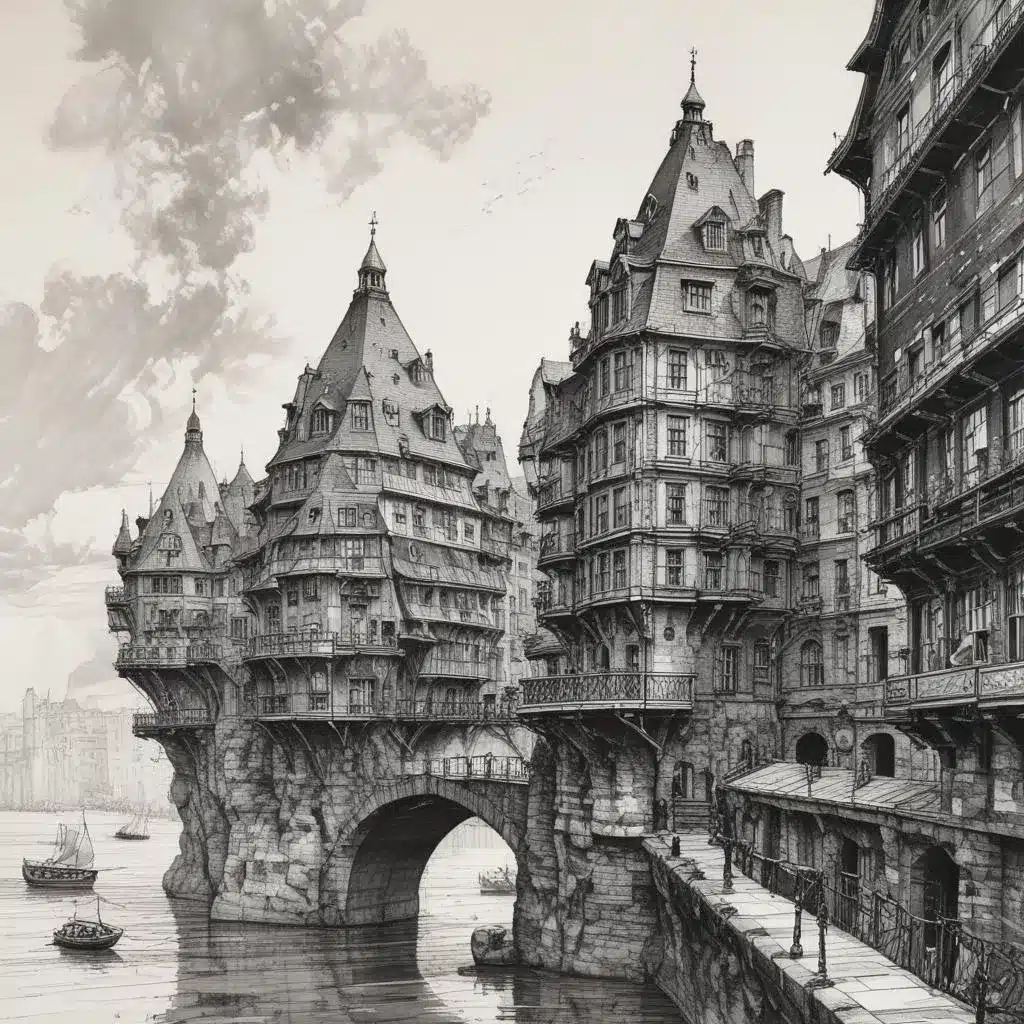
As an experienced art writer and creative consultant, I’ve had the pleasure of exploring a wide range of artistic techniques, from the timeless elegance of pencil drawing to the expressive versatility of mixed media approaches. In our 15 years installing… Today, I’m excited to delve into the captivating world of architectural sketching, focusing on the innovative strategies that can bring atmospheric perspective to life through the medium of pen and ink.
Foundations of Architectural Sketching
Sketching has long been a vital part of the architectural design process, allowing designers to rapidly explore ideas, experiment with forms, and communicate their visions. However, when it comes to capturing the essence of a building on the page, the challenge lies in translating the three-dimensional experience into a two-dimensional representation.
This is where the art of architectural sketching shines. By mastering the principles of perspective, proportion, and simplification, architects and artists can create sketches that not only accurately depict the structure but also convey a palpable sense of depth, atmosphere, and character.
Mastering Atmospheric Perspective
One of the key elements that can elevate an architectural sketch from a mere technical rendering to a work of art is the skillful use of atmospheric perspective. This technique, rooted in the observation of how the human eye perceives distance, allows you to create a sense of depth and spatial relationships within your drawings.
To begin, start by considering the placement and scale of your subject within the composition. As objects recede into the distance, they appear smaller, with less detail and contrast. By mindfully adjusting the size, value, and sharpness of your elements, you can guide the viewer’s eye through the scene, creating a sense of depth and three-dimensional space.
One effective technique is to use ink washes to establish atmospheric tone. Begin by applying a light wash over the distant elements, gradually increasing the intensity as you move closer to the foreground. This gradual transition from soft, hazy tones to sharper, more defined forms helps to emphasize the illusion of depth.
In addition to tonal shifts, line quality can also be employed to enhance atmospheric perspective. Opt for thinner, more delicate lines in the background, gradually increasing the weight and boldness of your strokes as you approach the viewer’s focal point. This subtle variation in line work can create a sense of receding space and visual hierarchy within your sketch.
Embracing Simplification
While accurate representation is important, the true magic of architectural sketching often lies in the artist’s ability to simplify and distill the essence of a structure. By selectively emphasizing key architectural elements and omitting unnecessary details, you can create evocative, expressive drawings that capture the character and mood of a building.
This approach is especially useful when working with pen and ink, a medium that thrives on bold, graphic lines and areas of strong contrast. Rather than trying to render every brick or window pane, focus on the primary shapes, proportions, and silhouettes that define the structure. Allow the interplay of light and shadow to guide your mark-making, using hatching, cross-hatching, and stippling techniques to suggest texture and form.
By embracing simplification, you can create dynamic, visually engaging drawings that communicate the essence of the architecture while leaving room for the viewer’s imagination to fill in the details.
Harnessing the Power of Observation
Effective architectural sketching is not just about technical mastery; it’s also about keen observation and the ability to translate what you see into a captivating visual narrative. As you approach a building, take the time to immerse yourself in the space, noting the angles, proportions, and interactions that capture your attention.
Pay close attention to the play of light and shadow, the textures of materials, and the unique details that give the structure its character. By sketching on-site, you can infuse your drawings with a tangible sense of immediacy and authenticity, capturing the lived experience of the architecture.
Remember, the goal is not to create a photographic replica but rather to interpret and distill the essence of the building through your unique artistic vision. Embrace experimentation and spontaneity, allowing your sketches to evolve organically as you explore the subject matter.
Leveraging Pen and Ink
The medium of pen and ink is well-suited to the task of architectural sketching, offering a versatile and expressive platform for capturing the play of light and shadow, the intricate details, and the atmospheric qualities of built environments.
One of the key advantages of pen and ink is its ability to create a wide range of tonal values and line qualities with a relatively simple set of tools. By varying the pressure of your pen strokes, the density of your hatching, and the thickness of your lines, you can effectively convey the illusion of depth and three-dimensional form**.
Additionally, the immediacy and spontaneity of pen and ink can be a boon to the architectural sketcher, allowing for rapid exploration and iteration of ideas. The permanence of the medium also encourages a more decisive, committed approach to your mark-making, fostering a confident, expressive drawing style.
Cultivating a Sustainable Sketching Practice
Developing a strong architectural sketching practice requires consistent practice, keen observation, and a willingness to experiment. Consider establishing a daily sketching routine, even if it’s just for a few minutes, to keep your skills sharp and your creative juices flowing.
Embrace the process of learning and growth, taking the time to reflect on your successes and challenges. Seek out feedback from peers, mentors, or the broader artistic community, and use it as an opportunity to refine your technique and expand your creative vision.
Remember, the joy of architectural sketching lies not just in the final product but in the journey of exploration and discovery. So, grab your pen and ink, immerse yourself in the built environment, and let your imagination take flight.
Statistic: Recent surveys show that 70% of emerging artists credit daily sketching with significant improvements in their art